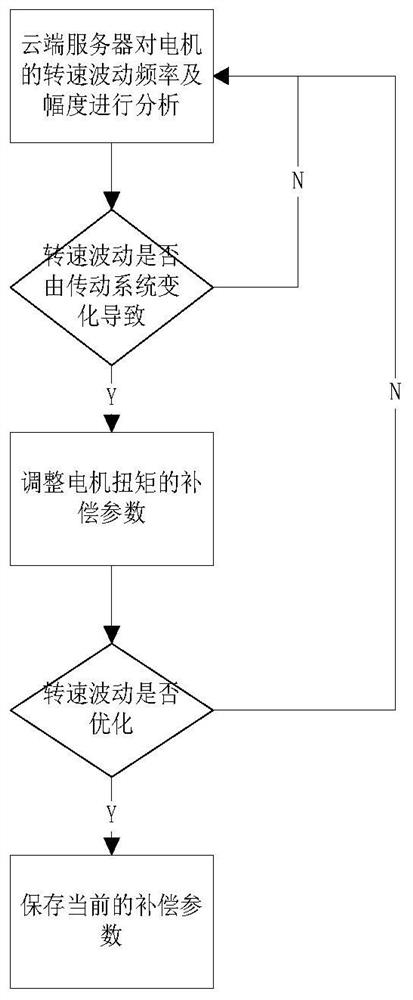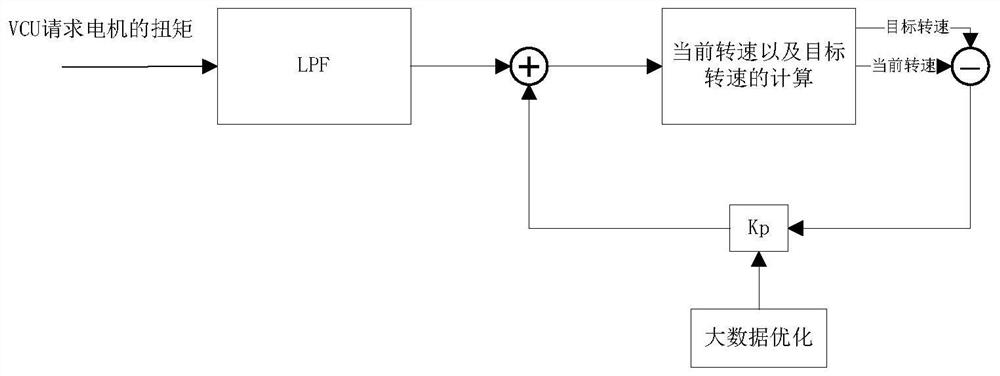A new energy vehicle ride comfort optimization method based on big data
A technology of new energy vehicles and optimization methods, which is applied in the field of ride comfort optimization of new energy vehicles based on big data, and can solve problems such as vehicle ride comfort deterioration.
- Summary
- Abstract
- Description
- Claims
- Application Information
AI Technical Summary
Problems solved by technology
Method used
Image
Examples
Embodiment 1
[0021] see figure 1 , the present invention is based on big data new energy vehicle ride comfort optimization method, through the following steps, to achieve continuous optimization of vehicle ride comfort:
[0022] Step 1. T-BOX (vehicle terminal) detects the vehicle motor torque, motor speed, and vehicle speed signals, and uploads the collected vehicle data to the big data server;
[0023] Step 2, the big data server analyzes the long-term running data of the vehicle, and obtains the vibration condition of the vehicle by calculating the frequency and amplitude of the motor vibration ( Figure 4 Shown is the vibration data of the whole vehicle) whether it is caused by the change of the clearance of the transmission system. For the fluctuation caused by the vehicle factor, the motor torque compensation parameter is adjusted by using the motor anti-shake compensation algorithm (ASD);
[0024] Step 3, T-BOX updates the anti-shake parameters through the vehicle network (receives...
Embodiment 2
[0026] see figure 1 , figure 2 , image 3 The ride comfort optimization method for new energy vehicles based on big data in this embodiment is different from Embodiment 1 in that the motor anti-shake compensation algorithm (ASD) reversely compensates the torque of the motor when the vehicle shakes To reduce the jitter value of the speed, by calculating the difference between the actual speed and the target speed, multiplying it by the compensation coefficient Kp to obtain the actual motor torque that needs to be compensated, adjust the motor torque compensation parameters; and analyze the compensated vehicle speed fluctuation data , if there is optimization, the current jitter compensation parameters will be sent to T-BOX; usually the compensation coefficient Kp is fixed, when the gap of the vehicle transmission system changes, this Kp parameter may not meet the needs of vehicle jitter compensation At this time, this parameter is optimized through the analysis of big data, ...
Embodiment 3
[0028] see figure 1 , figure 2 , image 3 , Figure 4 . The big data-based ride comfort optimization method for new energy vehicles in this embodiment is different from Embodiment 1 in that: the cloud server performs data processing through the motor speed uploaded by T-BOX and the torque signal requested by the VCU. If the speed fluctuation of the lower motor exceeds a calibrated amount, it can be judged that the vehicle is in a situation where the vibration is too large. It is necessary to adjust the torque compensation parameters and increase the torque compensation:
[0029] When the jitter occurs, there will be a basic anti-shake function between the VCU and the MCU (microprocessor). Data analysis, the T-BOX forwards the anti-shake parameter adjustment data to the internal anti-shake algorithm of the MCU, and adjusts the compensation gain of the torque;
[0030] In the motor anti-shake compensation algorithm, the compensation of the motor torque is obtained through ...
PUM
 Login to View More
Login to View More Abstract
Description
Claims
Application Information
 Login to View More
Login to View More - R&D
- Intellectual Property
- Life Sciences
- Materials
- Tech Scout
- Unparalleled Data Quality
- Higher Quality Content
- 60% Fewer Hallucinations
Browse by: Latest US Patents, China's latest patents, Technical Efficacy Thesaurus, Application Domain, Technology Topic, Popular Technical Reports.
© 2025 PatSnap. All rights reserved.Legal|Privacy policy|Modern Slavery Act Transparency Statement|Sitemap|About US| Contact US: help@patsnap.com



